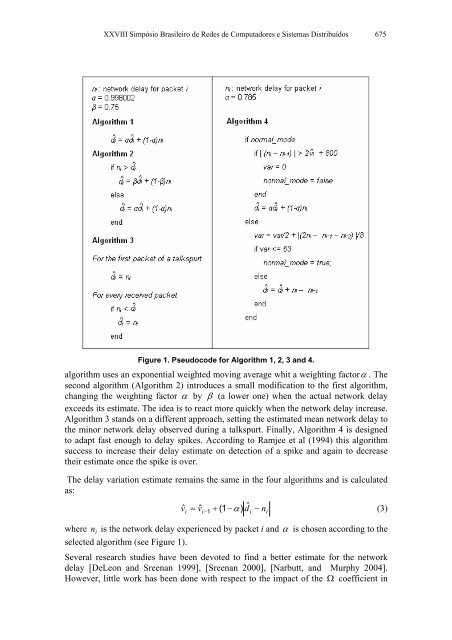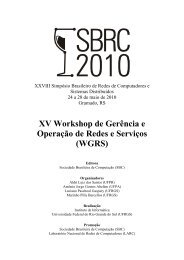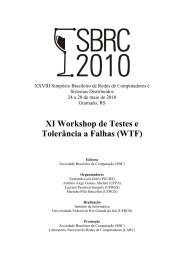Classical Playout Buffer Algorithm Revisited
Classical Playout Buffer Algorithm Revisited
Classical Playout Buffer Algorithm Revisited
Create successful ePaper yourself
Turn your PDF publications into a flip-book with our unique Google optimized e-Paper software.
XXVIII Simpósio Brasileiro de Redes de Computadores e Sistemas Distribuídos 675<br />
Figure 1. Pseudocode for <strong>Algorithm</strong> 1, 2, 3 and 4.<br />
algorithm uses an exponential weighted moving average whit a weighting factorα . The<br />
second algorithm (<strong>Algorithm</strong> 2) introduces a small modification to the first algorithm,<br />
changing the weighting factor α by β (a lower one) when the actual network delay<br />
exceeds its estimate. The idea is to react more quickly when the network delay increase.<br />
<strong>Algorithm</strong> 3 stands on a different approach, setting the estimated mean network delay to<br />
the minor network delay observed during a talkspurt. Finally, <strong>Algorithm</strong> 4 is designed<br />
to adapt fast enough to delay spikes. According to Ramjee et al (1994) this algorithm<br />
success to increase their delay estimate on detection of a spike and again to decrease<br />
their estimate once the spike is over.<br />
The delay variation estimate remains the same in the four algorithms and is calculated<br />
as:<br />
vˆ = vˆ<br />
− + (1−<br />
) dˆ<br />
1 α − n<br />
(3)<br />
i<br />
i<br />
where n i is the network delay experienced by packet i and α is chosen according to the<br />
selected algorithm (see Figure 1).<br />
Several research studies have been devoted to find a better estimate for the network<br />
delay [DeLeon and Sreenan 1999], [Sreenan 2000], [Narbutt, and Murphy 2004].<br />
However, little work has been done with respect to the impact of the Ω coefficient in<br />
i<br />
i







